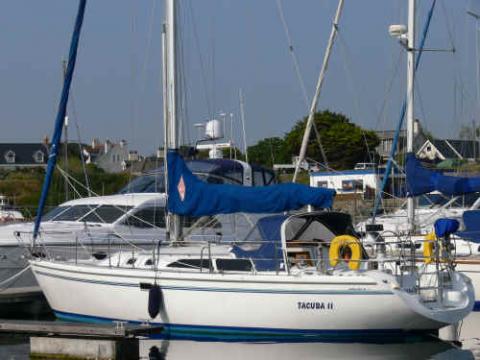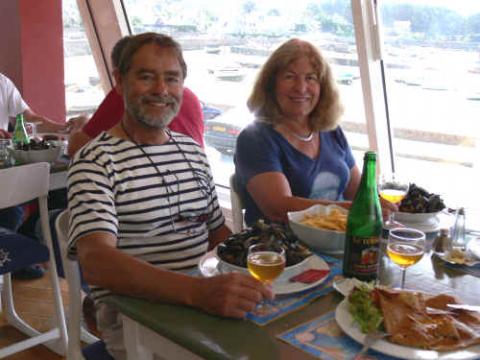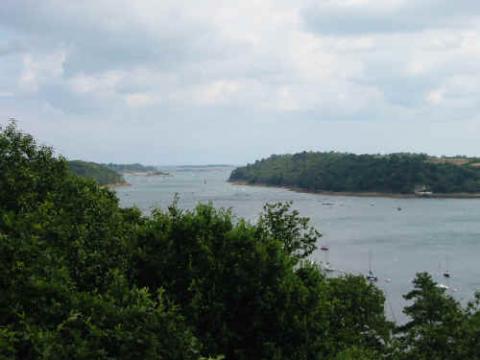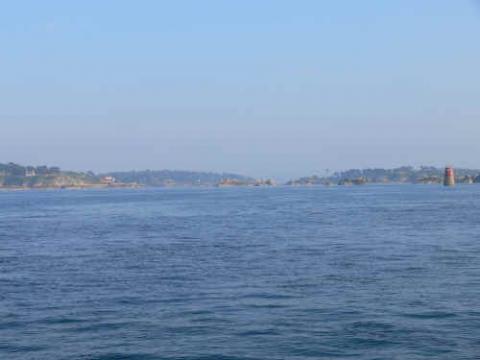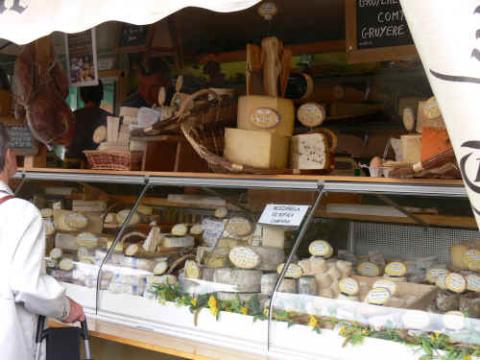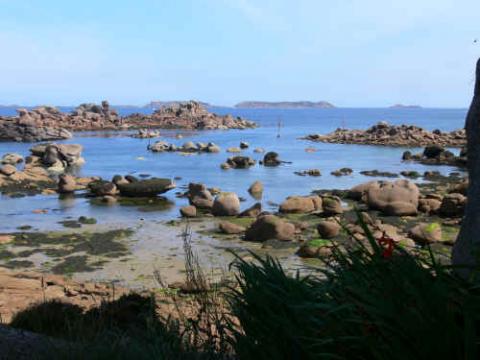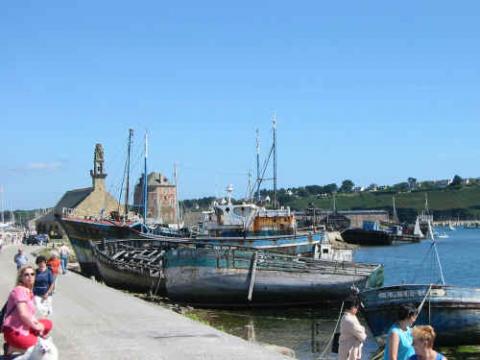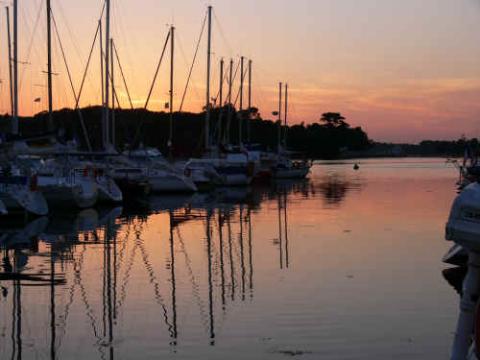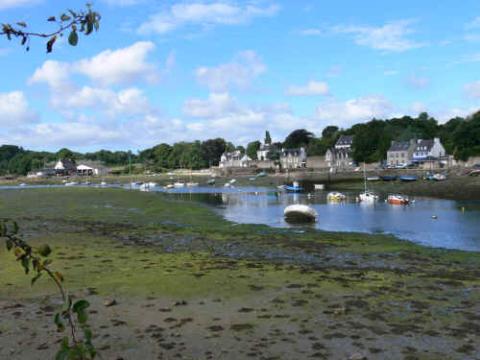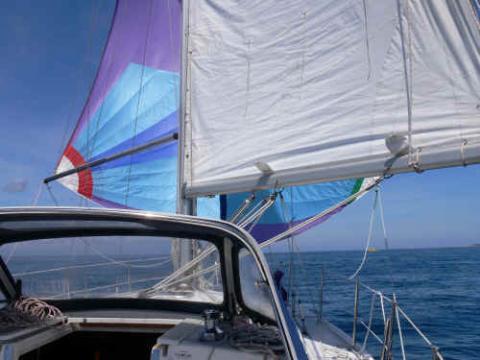Tacuba II’s Summer 2006 Trip To Brittany
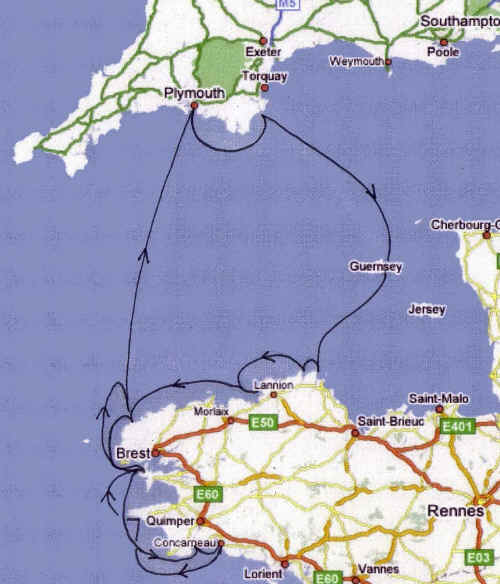
by Chris Savage
Tacuba II #1703
Devon, England
TACUBA II is the Catalina-36 Mk II that my wife, Margaret, and I bought in 1998 in The Netherlands, in anticipation of our retirement a couple of years later. Since then, we have cruised the Baltic Sea as far as Stockholm, the Ijsselmeer and Dutch waters generally, the Southern North Sea, and, since returning to live in the United Kingdom, the Channel Islands and Brittany. TACUBA II is now berthed in the Plymouth Yacht Haven just off Plymouth Sound in Devon, England.
June of 2006 saw us sailing off to sample, once again, the special delights of Brittany: the moules-frites, vins of all sorts of colours, ricard, cidre, crepes and calvados, together with horrendous tides and daunting offshore islands and rocks!
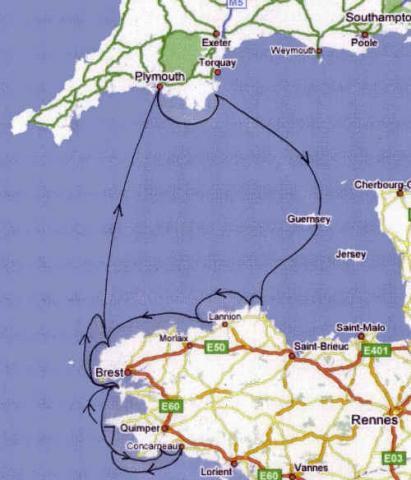
For those who don’t know, Brittany is located on the French mainland, in the northwest corner of Central France. The government in Paris considers it a part of France but the locals know better! For example, the first thing we had to do upon arrival was purchase a Brittany flag to fly under the French courtesy flag at the starboard crosstrees. It was a “local requirement” that this flag be larger than the official courtesy flag (not difficult to achieve as there only seemed to be very large flags on sale). Although only about 100 miles south of the English south coast, the climate in Brittany is noticeably warmer and more pleasant and that, combined with the different language, currency (France is in “Euroland”) and the culinary delicacies mentioned above, mean that in little over a day’s sail one is quite definitely “abroad”. Prices are also lower than in the UK, with marina prices close to half those at home. As a result, there are always plenty of British flags to be seen.
The trip this year was characterised by 5 weeks of sunshine, high temperatures and generally light winds, usually from in front. Our route took us to Guernsey in the Channel Islands, followed by the north and west coasts of Brittany and the south coast east to Port La Forêt near Concarneau. The return leg was planned to be a single night passage from West Brittany NNE home to Plymouth. For company, we had two friends, Keith and Sheila Wright, sailing their Dufour 31 “RUSALKA”.
Both boats sailed from Plymouth at 0930 on Monday, 26 June, destination Dartmouth, about 40 miles to the east. Amazingly, after many weeks of unbroken sunshine, it was raining. The wind was very light and we finally had to use the engine when the tide turned against us. The afternoon saw a change in the weather, the rain stopped and we finished the trip beating into an easterly F4. A minor medical problem (an attack of gout in my left knee – please don’t laugh) kept us in Dartmouth for another day but we got away on the Wednesday at the uncivilised time of 0450. Again there was very little wind and, with the exception of about an hour around lunchtime, we motored the 60 or so miles to Guernsey. In spite of the forecast, it was misty virtually all the way across, particularly stressful crossing the shipping routes north of Guernsey. RUSALKA has AIS and was reporting several important targets. We do not have AIS but we do have radar and we could see at least 7 more targets, probably a fishing fleet near the shipping lanes, living dangerously. Nothing large came close to us, however, and we were safely in Beaucette Marina on the northeast corner of Guernsey by 1700. Beaucette is a fascinating place. It used to be a quarry near the coast until some enterprising gentleman dynamited the rocks between quarry and sea. Now it is a very secluded and secure marina with an excellent restaurant.
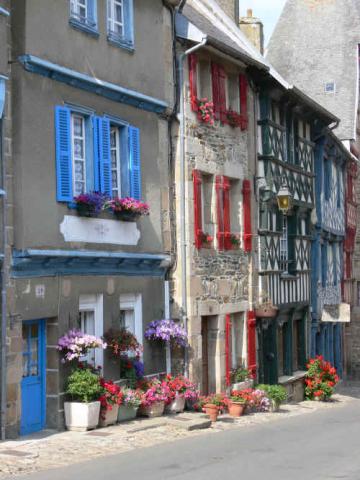
A couple of days later we set off to explore the Trieux and Tréguier rivers. These two rivers are quite close together and are deep, secure and very attractive. They are sheltered from seaward by the Île de Bréhat and an impressive plethora of off-lying rocks and reefs. The Trieux is the more straightforward to enter, as well as being the closest to Guernsey, so it was our first landfall in Brittany. The journey of about 60 miles was covered in just over 11 hours. It included a superb spinnaker leg through the Little Russel channel down the east coast of Guernsey and past the Island’s capital, St. Peter Port, followed by a frustrating period during mid-morning when in the lee of the island when the wind dropped to nothing for an hour or so. Otherwise, we enjoyed predominantly northwest winds and superb sunshine until tying up in the marina of Lézardrieux at 2000.
The Lézardrieux marina has all the usual facilities and there are several good restaurants in the immediate vicinity. The town itself, however, is a short but fairly steep walk away. Since the boulangerie is in the town, the early-morning pilgrimage to buy bread rolls for breakfast entails a brisk walk. The town also sports a lovely old church, right in the centre, a supermarket and several more restaurants and bars. The most attractive part of the area is, however, the river. It flows through a deep wooded valley and there are several superb walks with unbeatable views down the river and out to the English Channel beyond. One could profitably stay a week or more here, anchoring either in the river or visiting the spectacular Île de Bréhat but we needed to move on so 1110 on Sunday 2 July saw us motoring down the river in hot sunshine and nearly no wind.
The days run involved leaving the Trieux, sailing a few miles west and then sailing up the river Tréguier to the town of Tréguier itself. The trip took us about 51/2 hours and we logged 22 miles. The morning was hot and frustratingly slow but the wind filled in (from in front of us, of course) in the afternoon, giving a pleasant enough sail to end the day with.
The river Tréguier is similar in many respects to the Trieux except that it is protected near its entrance by extensive shallows. The river is quite wide at this point but it is essential to pass very close to the rocks on the east side, marked by the La Corne lighthouse, to stay in deep water. Fortunately, the passage is well marked and, once through, the river becomes straightforward and very picturesque. The town of Tréguier, which the pilot book had described as attractive, out-shone all our expectations. It is full of delightful old streets lined with well maintained but very old houses, all wooden beams and brightly painted. The cathedral in the centre of the town is well worth a visit, as are the many art galleries. We were fortunate in being there on the day of the weekly market. It is very large and extends along the river front and back right into the town centre. Everything, but everything, appeared to be on sale but I personally found the food stalls the most attractive, particularly the fresh fish, cheese, wine and olive stalls.
We stayed in Tréguier a little longer than originally intended, partly because we were enjoying ourselves but also because the weather, whilst still hot, had taken a turn for the worse, with thunderstorms and quite a lot of rain. On 4 July (I believe people celebrate this date somewhere – can’t imagine why…..) we gave the weather best and took a taxi ride to Lannion, a nice place but Tréguier is much prettier. We finally left the area of the two beautiful rivers on 6 July, heading west along the north Brittany coast.
The next port of call was a place called Trébeurden, a somewhat rambling place with a superb marina protected behind an automatic sill that allows passage in or out approximately 4 hours each side of high water. Of course, nobody wants to cut things too fine so we were aiming to go in about high water. Somewhat surprisingly (my crew was surprised, anyway!), after logging 41 miles in 8 hours against predominantly west winds of around F4, we passed over the sill 10 minutes after high water! This part of the coast is quite different from the area we had just left, being composed largely of pink granite cliffs and rocky islands behind which nestle many protected anchorages and harbours. It would be a marvellous place to glide gently past with sunshine and favourable wind and tide but, so far, we have always managed to beat past, usually with a foul tide. One day, perhaps,…..
The next leg of the trip was to be about 55 miles to the west so we were keen to have a fair wind. The result, predictably perhaps, was 4 days of strong west winds, laced with rain and even a genuine storm warning on the evening of the second day. We filled the time visiting some of the nearby attractions by bus and doing a few minor running repairs.
A particularly attractive harbour – certainly on the list for a future visit – is at Ploumanac’h, a few miles east of Trébeurden. It is completely protected behind granite outcrops and islands, although care is needed at the entrance that is protected by a very solid stone sill, albeit with a tide gauge. Once inside, it has a least depth of 1.9 metres at the moorings in the main channel, which is just about enough for us and would be plenty for RUSALKA.
Tuesday 11 July dawned with a favourable NW F4 forecast. The tides were fair for an early start so we were away at 0630. Of course, the NW4 was coming from the west at about F2-3 so progress was frustratingly slow. At least the sun was shining and it was warm. Quote from the log: “0800: slow progress, pitching into NW swell. Where is the NW4??” About midday, just north of the Roscoff ferry terminal and the Île de Batz, we gave in to the confused seas and light headwinds and motored the rest of the way to L’Aber-Wrac’h, rafting alongside another British yacht FIRE DANCER on a visitors’ buoy in what was by now a flat calm.
L’Aber-Wrac’h is a strategically important port, being only a few miles from the point where North Brittany turns sharply left to become West Brittany. This area is subject to some very strong tidal streams and can be rather treacherous if attempted in strong wind-against-tide situations. The first of these tidal gates is the Chenal de Four, a 10-mile stretch between the islands of Ushant and the Brittany coast, and L’Aber-Wrac’h is traditionally the place where one waits for the optimal conditions for the passage. The facilities are quite good but, other than the visitors’ buoys, there is only one jetty and that gets very crowded – there are plans to build a substantial marina during the next few months which will greatly improve matters. We spent a day here before sailing at 0600 on Thursday 13 July. The wind was very light and the Chenal de Four was a “pussy cat” with only the occasional oily turbulence to remind one of its reputation. We were finally able to switch the engine off at about 1000 and thereafter had a pleasant sail in a steadily increasing N-NE wind, finally mooring in the marina at Camaret-sur-Mer in time for a late lunch.
Camaret is a fascinating place, a popular holiday resort with many excellent restaurants and a very good fresh fishmonger. Just beside the marina is an old fort with, next to it, an equally old church. The church has a steeple with the top few feet missing. Apparently, in days past, the British had attempted to land an invasion force at Camaret, expecting it to be defenceless but had discovered the fort. In the ensuing battle, a British cannon ball knocked the top off the church steeple whilst trying to hit the fort. The invasion failed! Also nearby is a section of beach where old fishing boats go to die – all very picturesque if a little sad. Anyway, when we arrived, the town was a hive of activity and the evening witnessed great partying and a huge fireworks display. By coincidence, we had arrived the day before Bastille Day! On The Day Itself (14 July), the town hosted a massive shore-side market, and the previous evenings festivities continued throughout the next day and most of that night.
We spent a few days in Camaret, enjoying the hot sunshine and waiting out a strong wind warning. It was also the opportunity to investigate the somewhat odd boat behaviour during our arrival. In the end, Keith (skipper of RUSALKA), an experienced diver, went under our boat with a knife and hacked off a mass of seaweed that had bound itself around our autoprop. It was amazing stuff, nearly as tough as rope! Apparently it is Japanese and was imported inadvertently by merchant ships.
Camaret was the port at which we “split tacks” with RUSALKA, Keith and Sheila preferring to explore further the West Brittany cruising ground whilst we wanted to get a bit further south. Monday 17 July therefore saw TACUBA II, alone for the first time, heading off for the second of West Brittany’s tidal gates, namely the Raz de Sein. The Raz de Sein runs off the point where West Brittany turns left to become South Brittany. It is quite a short tidal race, only a mile or two, but quite exciting. Our ship’s log records 5.4 knots through the water with GPS SOG of 10.2 knots! Once past, one turns initially southeast and then east and encounters yet another very noticeable change in climate. I have no idea why anyone wants to go to the Mediterranean – the weather is already here in Brittany.
France also becomes much flatter at this point as the steep cliffs typical of West Brittany are replaced by rolling hills and open fields. After a promising start from Camaret, the wind turned very fluky in the afternoon and we ended up motoring in beautiful hot sunshine into the fishing port of Loctudy. The marina at Loctudy is very sheltered and excellently run. We were met near the entrance by the harbour master in a RIB who allocated us a berth – all very civilised. The marina is next door to the fishing harbour through which one walks to the town to collect the bread rolls for breakfast. The fishing harbour hosts a large fish auction every afternoon about 1700 and also has 3 excellent fresh fish shops. For those who like fresh fish, it is as close to Nirvana as one might hope!
After a couple of days in Loctudy, exploring the local beaches and just basking in the sunshine, we drifted the few miles past Bénodet to Port-La-Forêt near Concarneau. Although on the chart this whole region looks to be exposed to the Atlantic weather, it is actually very well protected by the off-lying islands, in particular the Iles de Glénan. As a result, it is an extremely popular French yachting area and consequently liable to be crowded.
Port-La-Forét was a far as we intended to go this trip and we spent 3 days there waiting for a favourable wind to start our return. The marina has all the usual facilities, including chandleries, boulangeries and restaurants. The town is a walk of a mile or so up the river but is well worth the effort. There is a bus service from the marina that we used to explore nearby towns such as the charming Quimper and Concarneau with its medieval walled town.
All too soon it was time to start back and at 0730 on 25 July TACUBA II drifted out of Port-La-Forét in a light westerly wind (on the nose, but we were used to it by now!). A combination of tides and wind had made it impossible to get from Port-La-Forét through the Raz de Sein in one day, so we headed for the anchorage at Ste Evette. This is about 10 miles from the Raz de Sein and would be convenient for the next days run to Camaret. The pilot book says there are a few visitors’ buoys but, if they are occupied it is possible to anchor just outside them. When we arrived at 2030, the visitors’ buoys were completely lost in a mass of anchored boats, completely filling the bay right out beyond the end of the quarter-mile long breakwater. Fortunately, it was a quiet night.
At about 0830 the next morning, the whole bay, including us, emptied and headed for the Raz de Sein. It all got quite competitive on the way – the performance of the Catalina-36 attracted several compliments from French sailors who had not come across the make before. Midday saw us all beating through the Raz de Sein in warm but misty conditions, after which the fleet dispersed, the wind died and TACUBA II motored the rest of the way to Camaret, arriving in a flat calm at 1430.
Thursday 27 July was spent charging batteries and stocking up with (mainly liquid) souvenirs for transport back to England. 1030 the following morning saw us clearing Camaret for the roughly 135-mile trip back to Plymouth. The tide was foul in the Chenal de Four and the wind very light. Even with the aid of the spinnaker, it took until gone 3 o’clock before we were through and able to shape course for Plymouth. By 1700 the wind had picked up nicely from the SW and was already too much for the spinnaker. The 1800 shipping forecast confirmed the rising wind and promised us SW 3-4 backing S 4-5 and increasing 6-7. Deciding that discretion was the better part of valour, the trip was aborted and we turned back for L’Aber-Wrac’h where we rafted up just as night was falling about 2130.
The wind arrived during the night, accompanied by plenty of rain, and the bad weather continued through the next day. We finally got away on Sunday morning (30 July) at 0600 in a SSW F4 with overcast sky. The first 4 hours required the assistance of the “iron topsail” but by mid-morning the wind had filled in and the spinnaker was pulling along nicely. The midday forecast promised us SW 4-5 increasing 6 later and indeed the spinnaker was down an hour later as the wind reached F5. The afternoon was straightforward, with the autopilot steering us fast through smooth seas and hot sunny weather. During this period the potential boredom was relieved by crossing the east- and west-going shipping routes, all without incident. The wind picked up during the early evening, reaching F7 for an hour or so and requiring a reef and several rolls in the genua to maintain comfort (for the autopilot!). At 2100 we were treated to the romantic sight of the Eddystone lighthouse, flashing close abeam against the backdrop of a superb sunset. The remaining 15 miles back to Plymouth seemed to go very quickly and TACUBA II was all safely tied up back in her berth just before midnight. The 109 miles had taken just on 18 hours, an average of 6 knots, altogether a very pleasant end to the cruise.
Both TACUBA II and her crew had survived the 5-week trip in remarkably good order, in celebration of which a bottle of rather good French wine was opened and demolished before bed and the official end of the trip at 0100!

